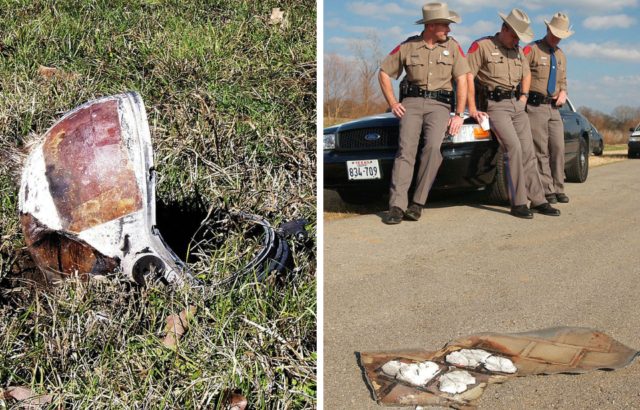January 28, 1986 — a day that began with hope, pride, and history in the making… ended in a fireball that silenced a nation. Millions watched live as the Space Shuttle Challenger — carrying seven brave astronauts, including teacher Christa McAuliffe — exploded just 73 seconds after liftoff, scattering burning debris across the Atlantic Ocean.
It was supposed to be America’s next great leap into space.
Instead, it became one of the most haunting tragedies in modern history.
🌊 The Ocean That Held the Truth
In the hours after the explosion, confusion turned to panic — and hope turned to heartbreak. Navy divers plunged into the freezing Atlantic waters, searching desperately for signs of life. But what they found beneath the waves told a story far darker than anyone imagined.
For weeks, wreckage and debris surfaced piece by piece — twisted metal, scorched panels, fragments of the shuttle’s once-proud frame. Each recovery was a painful reminder of how quickly triumph had turned into tragedy. But one question haunted every rescuer, every family member, every engineer:
👉 Where was the crew cabin?
💀 The Grim Discovery
On March 7, 1986, more than a month after the disaster, divers made a chilling discovery: the remains of the crew cabin, lying nearly 100 feet below the surface of the Atlantic. It was crushed and torn apart — but still recognizable. And inside… lay the final evidence of the Challenger’s seven heroes.
Forensic teams recovered human remains — shattered, fragmented, and degraded by saltwater and force. The discovery confirmed the worst: the crew did not survive the impact, though evidence suggested some may have remained conscious for the horrifying fall back to Earth.
NASA’s investigators worked tirelessly, piecing together telemetry data, camera footage, and fragments of the shuttle. The conclusion was devastatingly clear:
➡️ A single rubber O-ring seal on the right booster failed.
➡️ Flames escaped, ignited the external fuel tank, and tore the shuttle apart.
A tiny flaw — one overlooked detail — had doomed an entire crew.
🕯️ Handled with Honor, Buried with Grace
NASA treated the crew’s remains with the highest respect and secrecy. Families were consulted at every step, and recovery teams worked under complete confidentiality.
Some remains were returned privately to families for burial. Others were cremated and interred at Arlington National Cemetery, in a quiet ceremony closed to cameras, attended only by loved ones and NASA officials.
Their names — Francis Scobee, Michael Smith, Ronald McNair, Ellison Onizuka, Judith Resnik, Gregory Jarvis, and Christa McAuliffe — are forever etched into American history.
Heroes who reached for the stars, and paid the ultimate price. 🌠
⚙️ The Aftermath: A Lesson Written in Fire
The Rogers Commission investigation didn’t just uncover a mechanical flaw — it exposed a deeper one: pressure, politics, and pride inside NASA. Engineers had warned of O-ring issues in cold weather. Some believed the launch should have been delayed. But the mission went on… and tragedy followed.
In the years that came after, NASA completely overhauled its safety systems. The agency learned, painfully, that innovation means nothing without caution.
Every future mission — from Discovery to Endeavour — carried the silent memory of Challenger’s fallen crew.
💫 The Legacy That Lives Beyond the Wreckage
Today, nearly four decades later, the ocean has surrendered its secrets — but the echoes of that morning still linger. The Challenger’s remains, and the resting places of its crew, are a reminder of both human brilliance and human fragility.
We remember not just how they died, but why they flew — for discovery, for knowledge, for the unyielding belief that we can always reach higher.
👉 The Challenger disaster didn’t end in that explosion.
It lives on — as a warning, a lesson, and a legacy that continues to guide every astronaut who dares to touch the stars.





